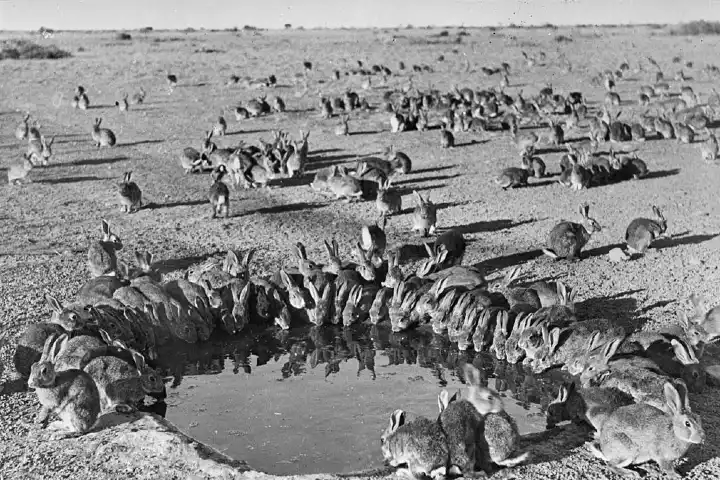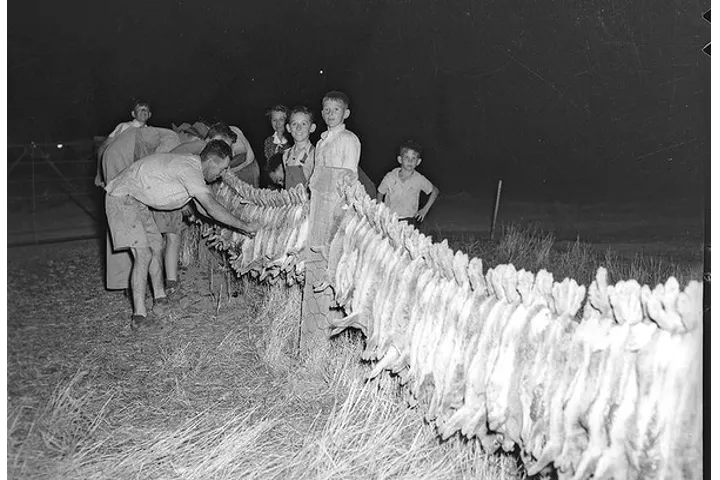

Invasive rabbits in Australia cause loss of agricultural produce and also threaten the existence of several species of plants and animals (Pics. Courtesy wikimedia commons)
At times one wrong move can have a cascading effect that can be felt for several decades. A standing example of this can be seen in Australia where wild rabbits of European origin by eating up the crops and pastures are bringing down agricultural productivity while posing a challenge to the native species by fighting for scarce resources, as per a report in smithsonianmag.com.
These species are posing a threat to 300 types of animals and plants while the destruction they cause to agriculture is to a tune of $200 million every year.
Interestingly, the analysis of the genes of these rabbits has revealed that their strong number of 200 million can trace their ancestry to probably just a single shipment of 24 of these animals.


The scientific research which has been published in the Proceedings of the National Academy of Sciences, gives credence to an earlier theory suggested by historians that the rabbit menace of Australia emanated from one estate.
It all started in 1859 when on Christmas, a wealthy English settler in Australia, Thomas Austin, received 24 wild and domestic rabbits from his brother in England.
Talking about that episode, Francis Jiggins, one of the authors of the study, told Nature News: “That single event triggered this enormous catastrophe, ecologically and economically, in Australia.”
Jiggins is an evolutionary geneticist at England’s University of Cambridge.
What is noteworthy is that this was not the first time that rabbits were stepping on this continent. These mammals had reached Australian shores with the first British colonisers who had arrived in 1788. Following this in the next 70 years, these creatures had been introduced in the region 90 times.
Yet Austin’s case was the turning point since it was after this, they virtually swamped the region. The rabbit population increased across the land at more than 60 miles per year and in 50 years they covered the continent. Six years after receiving his gift, in 1865, Austin shared with the local newspapers that had killed 20,000 of these creatures on his property.
Scientists to confirm the origin of these animals conducted a genomic analysis of 187 European rabbits that had been ensnared from 1865 to 2018 in Tasmania, Australia, Great Britain, New Zealand and France. It came to the fore that a large number of the Australian rabbits on the mainland were similar genetically and their ancestry was a mix of wild and domestic.
It was also found there was a lot of similarity between the Australian rabbits and the one from southwest England – from where Austin’s family had picked up these mammals to be sent to him. By closely examining the mitochondrial DNA – which comes to the offspring from mother – it was also revealed that a large number of Australian rabbits had descended from five females introduced from Europe.
The rabbits gifted to Austin had wild ancestry which provided them an edge to survive in Australia. In comparison to the domestic ones, they had better capability to avoid predators and also adapt to the terrain, Joel Alves, a co-author of the study, told Nature News. Alves is an evolutionary geneticist at the University of Oxford.
Another distinctive advantage that these rabbits enjoyed was that in the mid-19th Century, the people who were converting the outback into pastures had killed the predators of these rabbits, thus making their survival easier and comfortable.
Australia’s University of Adelaide ecologist, David Peacock believes that the entire blame of rabbit invasion should not be put on Austin. In a study of 2018, which he had co-authored he had suggested that there were several introductions of rabbits that led to the invasion by these creatures. He told Science that apart from Austin’s rabbits, there were others also introduced at the same time.
Peacock believes that the present study has a value as it could help in eradication of these invasive species. He told Science: “The better [we understand] the origin, spread, and genetics, the better we can manage Australia’s most serious pests.”
India decisively asserted its military superiority over Pakistan during this month's brief but intense conflict,…
Trade associations and local business groups in Pakistan-occupied Gilgit-Baltistan (PoGB) launched an indefinite protest on…
A human chain and protest march was organized by various organizations in front of the…
The United States on Saturday announced the expansion of its security partnerships with India through…
Highlighting the use of indigenous platforms during Operation Sindoor, Chief of Defence Staff (CDS) General…
Congress MP Shashi Tharoor on Friday (local time) said that Colombia will issue a statement…